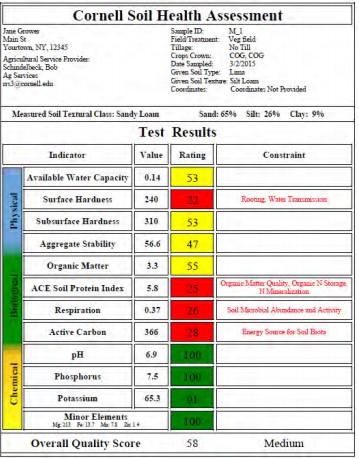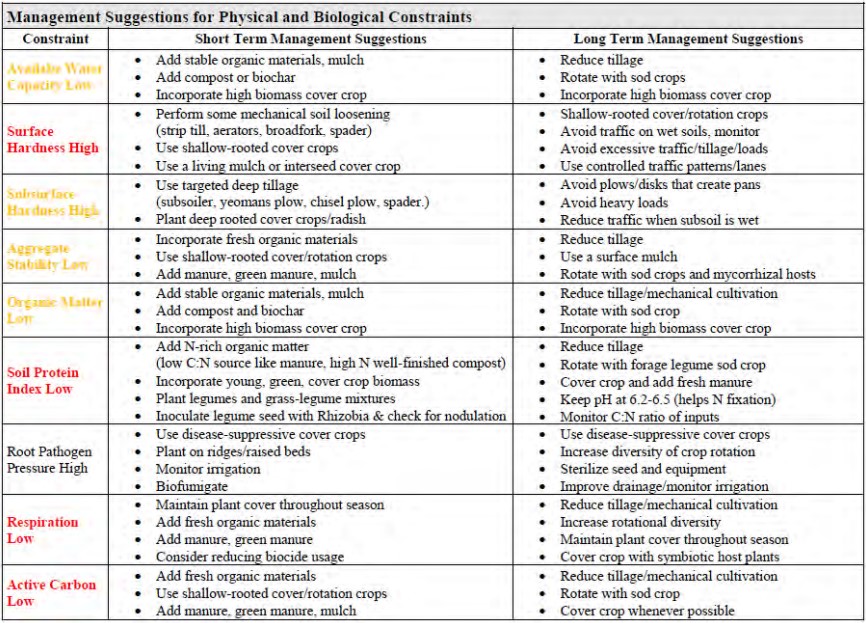You’ve probably seen this motto: “Feed the Soil, Not Just the Plants!” Doing that helps the soil prosper, and then the crop health and grower’s prosperity grow accordingly. This motto may somewhat represent the tilt towards “regenerative” or “sustainable” agriculture globally.
In the old days, feeding the plant necessary nutrients may have been adequate. But doing that disregards the quality of the soil and, in the long run, impacts the growth of crops and the profitability of the farm.
Here’s a rough definition of soil health, taken from a document at Cornell University: …”the continued capacity of the soil to function as a vital living ecosystem that sustains plants, animals and humans (NRCS, 2012). Characteristics of a healthy soil include good soil tilth, sufficient rooting depth, good water storage and drainage, rich and diverse soil life, stored carbon and an adequate supply of nutrients.”
There are three overlapping elements involved in assessing soil health: its physical nature as well as its biological and chemical properties. Managing nutrients only amounts to paying attention to just one of the three component parts.

In the above graph (developed by Cornell University) you can see a hypothetical analysis of a farm, wherein the chemical elements are all in the “green” or “ok” realm, but the physical and biological aspects are suffering. This is typical of farm acreage that has been in continuous tillage and mono-cropping for decades. So, even with the chemical aspect getting a passing grade, the overall quality of the farm soil is only “medium.” Medium won’t ever give you the best performance.
As the chart shows, some of the aspects of the soil’s physical health include its water carrying capacity, or “infiltration”. It also looks at compaction at the surface and down to about typical plowing depth.
Among the soil properties under the “Biological” heading, the assessment looks at the amount of organic matter, the “Autoclaved Citrate Extractable (ACE) Protein. which indicates the amount of protein-like substances present in the organic matter, the soil’s respiration and the amount of active carbon.
Though it might occur to you that there would be a lot of expense to assessing your fields’ soil health to this extent, agronomists at Cornell would disagree. “Qualitative, on-farm, in-field assessment of soil health does not need to involve special analyses, only the informed observation and interpretation of soil characteristics. This is usually done by visual assessment, but the smell and feel of soil may also be involved. Field test kits for measuring several indicators are also available (e.g. NRCS soil quality test kit).“
The article goes on to say that, “While this approach is more subjective and therefore can reflect user bias, the results can be very informative in making management decisions when detailed guidelines and training have been provided.”
Finally, the article says that, “The health of a soil can change over time as a result of use and management, therefore it is crucial to measure soil improvement when implementing new or modifying current management practices. Climate change, particularly the impacts of CO2 and N2 O, can be mitigated through improved soil health management while at the same time building soil resilience.”
Cover crops are an integrated part of the solution, part of moving away from nutrient management to soil health management. See the following management suggestions, again provided by the Ag Sciences folks at Cornell University. For each “constraint” against soil health, there are corresponding short term and long term management suggestions.

